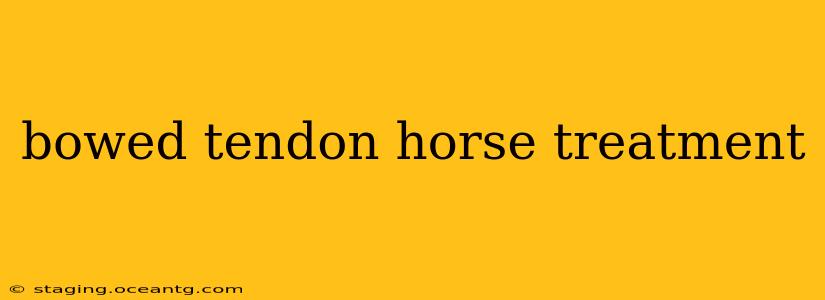A bowed tendon, formally known as a flexor tendon injury, is a serious and debilitating injury in horses, often affecting their performance and well-being. It involves damage to the superficial digital flexor tendon (SDFT) or deep digital flexor tendon (DDFT), crucial for supporting the horse's leg and enabling movement. This comprehensive guide explores bowed tendon treatment, recovery processes, and preventative measures to help horse owners understand this condition thoroughly.
What is a Bowed Tendon?
A bowed tendon occurs when one or both of the flexor tendons in a horse's leg are stretched or torn. This stretching and tearing causes inflammation and swelling, leading to the characteristic "bowed" appearance of the affected leg. The severity of the injury varies, ranging from minor strains to complete ruptures. The severity impacts treatment duration and the horse's overall prognosis. The front legs are most commonly affected, although bowed tendons can occur in hind legs as well.
What Causes a Bowed Tendon?
Several factors can contribute to bowed tendons in horses:
- Overexertion: Intense training, particularly on hard surfaces, is a leading cause.
- Sudden impacts: Falling, slipping, or striking a hard object can severely strain the tendons.
- Poor conditioning: Horses that are not adequately fit are more susceptible to injury.
- Underlying conditions: Problems with conformation (the horse's physical structure), hoof imbalances, or existing leg injuries can increase the risk.
- Improper training techniques: Incorrect riding style or training methods can put excessive stress on the tendons.
How is a Bowed Tendon Diagnosed?
Veterinary diagnosis is crucial. Your veterinarian will conduct a thorough physical examination, assessing the leg for swelling, heat, pain, and the characteristic bowing. Imaging techniques like ultrasound are typically used to determine the extent of the damage to the tendon and guide treatment planning.
Bowed Tendon Treatment: What are the Options?
Treatment focuses on rest, reducing inflammation, and promoting healing. The specific approach will depend on the severity of the injury:
- Rest: Complete stall rest is essential in the initial stages, followed by a gradual return to exercise under strict veterinary guidance.
- Cold therapy: Applying cold packs helps reduce swelling and inflammation.
- Bandaging: Supports the leg and minimizes movement.
- Anti-inflammatory medications: These drugs help reduce pain and inflammation.
- Shockwave therapy: This non-invasive treatment uses sound waves to stimulate healing.
- Interferon therapy: Used to reduce inflammation and scar tissue formation.
- Surgery: In cases of severe tendon damage, surgery may be necessary to repair the tear.
What is the recovery time for a bowed tendon?
Recovery time varies greatly depending on several factors, including the severity of the injury, the horse's age, and the effectiveness of the treatment. Minor injuries might take a few months, while severe cases can require a year or more before the horse can return to full athletic activity. Regular veterinary checkups and adherence to the prescribed rehabilitation program are essential for successful recovery.
How long does it take a horse to recover from a bowed tendon?
This directly relates to the answer above. The recovery process is lengthy and requires patience and consistent veterinary care. It's not simply a matter of weeks; it's a measured, careful return to activity, often stretching over months, to avoid re-injury.
What is the prognosis for a horse with a bowed tendon?
The prognosis depends largely on the severity of the injury and the effectiveness of the treatment. Many horses make a full recovery and return to their previous level of performance, but some may experience limitations in their athletic capabilities.
Can a horse with a bowed tendon be ridden again?
Yes, many horses with bowed tendons can return to ridden work, but this requires a gradual and careful return to activity, under strict veterinary supervision. The horse's fitness level and the severity of the injury will influence the timeline. Jumping or intense athletic pursuits may be limited or impossible, depending on the individual case.
Preventing Bowed Tendons: Proactive Measures
Prevention is key! Several measures can significantly reduce the risk of bowed tendons:
- Proper conditioning: Gradually increase training intensity to avoid overexertion.
- Appropriate footing: Avoid hard surfaces whenever possible.
- Regular farrier care: Maintain balanced hooves to minimize stress on the legs.
- Proper nutrition: Ensure the horse receives a well-balanced diet to support tendon health.
- Careful riding technique: Use correct riding practices to avoid placing undue stress on the tendons.
Bowed tendons are a serious concern for horse owners, but with prompt diagnosis, appropriate treatment, and diligent rehabilitation, many horses can make a full or near-full recovery. A collaborative effort between owner, veterinarian, and farrier is essential to maximize the horse's chances of a positive outcome. Remember to consult your veterinarian for any concerns regarding your horse's health. They are the best resource for diagnosis and treatment planning.
